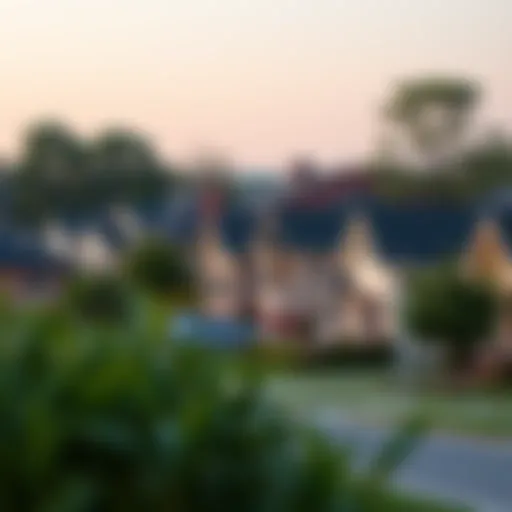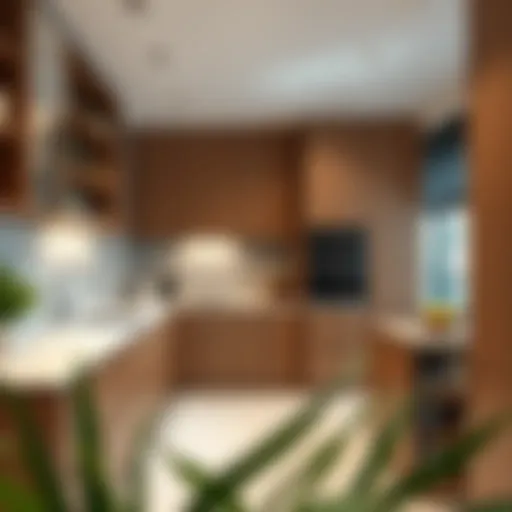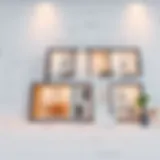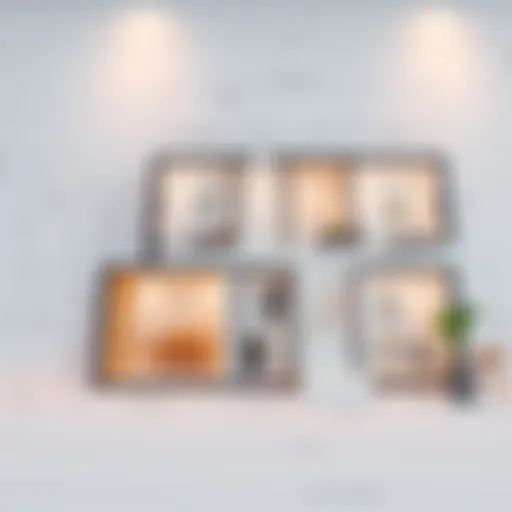Effective Methods for Cleaning Laminate Wood Floors
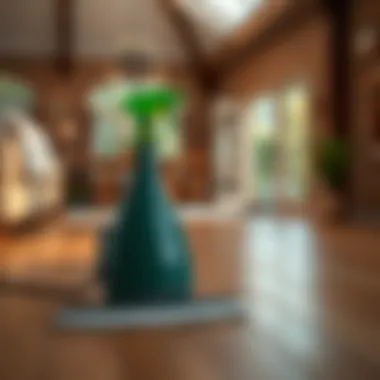
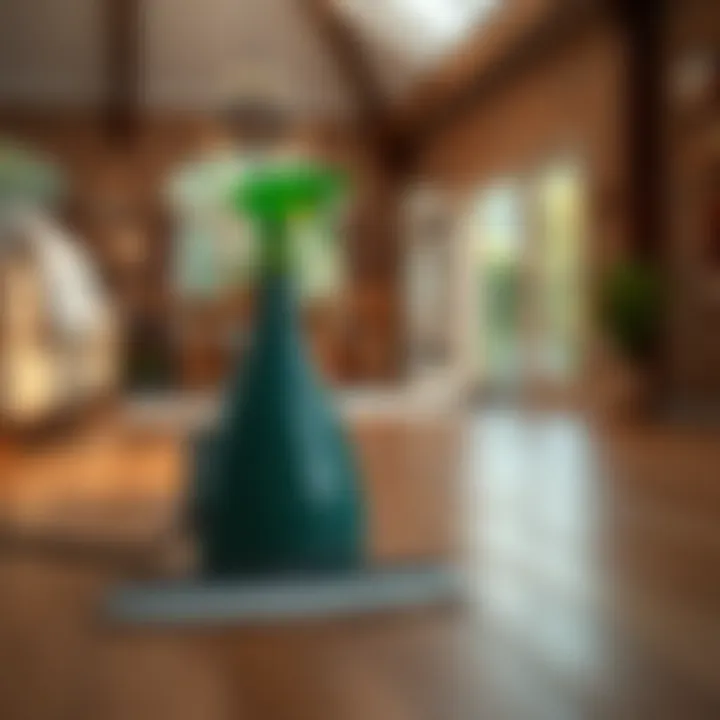
Intro
Laminate wood floors have become a popular choice in homes today, thanks to their appealing appearance and practical benefits. They can mimic the look of real wood without the hefty price tag, making them a smart option for budget-conscious homeowners. However, with this choice comes the responsibility of keeping them clean and in good condition. Unlike traditional hardwood, laminate flooring requires specific care methods to ensure its longevity and aesthetic appeal.
For many, the idea of cleaning and disinfecting surfaces might seem straightforward at first glance. Yet, laminate floors present their own unique challenges. Identifying the right products and techniques is vital to avoid damage. This guide delves into effective strategies for maintaining laminate wood floors, emphasizing the techniques crucial for both cleaning and disinfecting.
In understanding these methods, homeowners will not only preserve the beauty of their laminate floors but also create a healthy living environment. Today's readers can expect to find detailed step-by-step guides, essential disclaimers regarding cleaning products, and an explanation of key differences between cleaning and disinfecting. This journey intends to empower not just homeowners but also cleaning professionals with a well-rounded understanding of cleaning laminate flooring.
Intro to Laminate Wood Floors
Laminate wood floors have become a staple in many homes, offering an appealing combination of aesthetics and practicality. These floors replicate the richness of hardwood while providing increased durability and resistance to scratches and moisture. This makes them a favored choice for high-traffic areas where traditional wood might falter. Knowing about laminate floors is important as it helps homeowners and buyers alike to appreciate how they can blend beauty with functionality.
One significant aspect of laminate flooring is its construction. Comprised of multiple layers—high-resolution photographic wood image layers, which offer stunning designs, along with a protective top layer—these floors often outlast genuine hardwood in various environmental conditions. Because laminate is largely moisture-resistant, it's not just suitable for living rooms and bedrooms, but it also works well in kitchens and basements where humidity can put traditional wood floors at risk.
Furthermore, laminate wood floors are relatively easy to maintain. However, improper cleaning methods can lead to damage over time, which is where this article comes in. Proper knowledge of effective cleaning and disinfecting methods not only prolongs the life of the flooring but also ensures a healthier living environment.
In the ensuing sections, we’ll delve deeper into the essential concepts around laminate flooring, from understanding its layers to exploring cleaning techniques. This discussion will round out our knowledge base about laminate floors—equipping homeowners and cleaning professionals with the necessary insight to keep these surfaces both clean and appealing.
“A well-maintained floor can speak volumes about a home.”
As we move forward, it’s important to keep in mind that with the right approach, maintaining laminate flooring can be a straightforward endeavor. Knowing what works and what doesn’t means that keeping your floors polished isn’t just a chore; it’s a straightforward way to promote health and beauty in your living spaces.
Understanding the Composition of Laminate Flooring
Understanding the composition of laminate flooring is foundational for homeowners and cleaning professionals alike. Laminate floors often get a bad rap for being merely economical alternatives to solid hardwood or tile, but digging a little deeper reveals their unique, complex build. This knowledge not only aids in making informed purchases but also assists in choosing the right cleaning and maintenance methods that preserve both functionality and aesthetics.
Each layer of laminate flooring serves a purpose, contributing to durability, ease of installation, and even design versatility. Being aware of how these elements work together can enhance one’s approach to cleaning and disinfecting, ensuring these floors remain as captivating as the day they were installed.
Layers of Laminate Flooring
Laminate flooring is constructed of multiple layers, each with its specific function. Understanding these layers helps highlight why particular cleaning methods are recommended.
- Wear Layer: This is the topmost layer designed to resist scratches, stains, and fading. It is often transparent and can vary in thickness, influencing how well it withstands daily foot traffic.
- Design Layer: Underneath the wear layer lies the design layer which typically features high-resolution images that mimic wood, stone, or other materials. It's important to recognize that harsh chemicals can damage this layer, leading to fading or discoloration.
- Core Layer: The heart of laminate flooring is the core layer, usually composed of high-density fiberboard (HDF) or medium-density fiberboard (MDF). This layer provides stability and strength, forming the foundation that household activities depend on. It is crucial not to expose this layer to water excessively, as it can lead to warping.
- Backing Layer: The backing layer serves as a moisture barrier. If this layer is compromised by too much water during cleaning, it can cause the laminate to bubble, lose its integrity, or warp.
By breaking down these layers, homeowners can approach cleaning with a clear understanding of how to protect each aspect of their flooring. Using too much moisture can ruin the backing or core, while abrasive cleaners may scratch or dull the wear layer.
Benefits of Laminate Floors
The growing popularity of laminate flooring is no accident. Several advantages contribute to its widespread adoption, appealing to various homeowners and renters alike. Some of the standout benefits include:
- Affordability: Laminate flooring typically costs less than hardwood or natural stone, making it accessible for many budgets.
- Easy Installation: Many laminate floors are designed with interlocking systems that make installation a breeze. This DIY aspect is appealing for those looking to save on labor costs.
- Diverse Styles: The printing techniques used in the design layer result in a myriad of styles. From rustic wood looks to sleek tiles, you can find something for every aesthetic preference.
- Durability: With proper care, laminate floors can last a long while. They are resistant to many elements that can damage other flooring types, like scratches and moisture.
- Minimal Maintenance: Cleaning laminate floors does not require extensive labor. A dust mop or a damp cloth is usually enough to keep them looking their best with occasional deeper cleans.
In summary, understanding the composition of laminate flooring sheds light on its ongoing maintenance needs. These floors remain a smart choice for those desiring a blend of beauty and function.
Importance of Cleaning and Disinfecting Laminate Floors
Cleaning and disinfecting laminate floors is not just about aesthetics; it’s about creating a safe and healthy living environment. Laminate floors, while resilient and easy to maintain, can harbor dirt, bacteria, allergens, and staining substances if not properly cared for. Regular cleaning not only preserves their appearance but also extends their lifespan, making maintenance an integral part of home care.
Health Considerations
When it comes to health, the significance of cleaning cannot be overstated. Dust particles and allergens can accumulate on laminate surfaces, making the air in your home less than ideal. Exposure to these irritants can lead to respiratory issues, especially for individuals with allergies or asthma. Thus, systematic cleaning helps minimize these health risks.
- Bacterial Growth: Without proper cleanup, bacteria can thrive on surfaces, especially in high-traffic areas. Disinfecting ensures that potentially harmful pathogens are removed, reducing the likelihood of illness among occupants.
- Allergen Reduction: Regular upkeep helps eliminate triggers such as dust mites and pet dander, creating a healthier living space.
For optimal health, consider using cleaning agents with disinfectant properties. However, it’s crucial to choose products that are safe for laminate floors to avoid damage. Always follow the manufacturer's instructions regarding cleaning.
Aesthetic Preservation
The visual appeal of laminate flooring contributes heavily to the overall aesthetic of a home. Stains, scuff marks, and accumulated grime can drastically alter the appearance of these surfaces. Maintaining cleanliness helps ensure that floors remain vibrant and attractive, avoiding unnecessary replacement costs due to neglect.
- Visual Impact: A clean floor reflects light beautifully and enhances the overall ambiance of a room. Conversely, a dirty or stained floor can make even the most carefully decorated space look unkempt.
- Longevity: Consistent cleaning routines can protect the finish of laminate wood, preventing wear and tear that can lead to costly repairs or replacement.
Regular cleaning, combined with preventative measures, maintains your floors’ shine. Utilizing appropriate cleaning products and methods, you can preserve their attractive look while avoiding early deterioration.
Keeping your laminate floors clean and disinfected benefits both health and aesthetics — a win-win for any homeowner.
In sum, the practice of cleaning and disinfecting laminate floors transcends mere household maintenance. It ultimately fosters a safer living environment while ensuring that your home remains visually appealing.
Materials and Tools Required for Cleaning
When it comes to cleaning laminate wood floors, having the right materials and tools is half the battle won. The effectiveness of your cleaning regimen is deeply intertwined with what you use. It’s not merely about grabbing any cleaner or mop lying around. Instead, selecting the appropriate items can significantly safeguard your floor's sheen and lifespan.
Cleaning Solutions
Choosing the right cleaning solution is akin to selecting the best wine for your meal; it can elevate the entire experience. You may think any all-purpose cleaner would do. But laminate floors are specific creatures. Using inappropriate cleaners could lead to dullness or even irreversible damage. Here are some notable options:
- pH-neutral cleaners: These are widely recommended as they are gentle on laminate yet tough on dirt. They won’t strip the floor’s finish and prevent the grimy build-up that can happen with harsher chemicals.
- DIY solutions: A simple mixture of vinegar and water can be effective for many homeowners. However, avoid using too much vinegar; a splash mixed with water should suffice. It gives a decent shine without the negatives that come from stronger acids.
- Commercial products: Look for brands that specifically state they are safe for laminate. Always read labels and claims carefully. Some products may sound effective but could contain substances that can harm your floors. Opt for recognized names in the flooring care industry like Bona or Bruce.
It’s essential to remember that mere cleaning isn’t enough; disinfecting should also be part of the equation. While cleaning removes dirt and stains, disinfecting is what ensures a healthier environment, particularly in homes with children or pets.
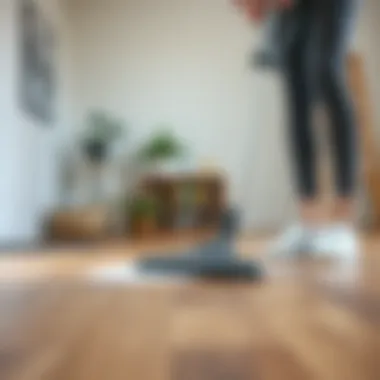

Cleaning Tools
The tools you use to apply these cleaning solutions play just as critical a role. Picture yourself with a blunt knife trying to cut through a steak; it simply won’t do. Having the right tools allows for effective application and enhances the overall cleaning efficiency. Below are some must-have cleaning tools:
- Microfiber mops: These are the workhorses of floor cleaning. They gather dirt effectively without scratching the surface. The microfiber material can also trap allergens, giving you a double whammy of benefits.
- Soft bristle brushes: When it comes to stubborn spots, you might need an agile brush that won’t mar the laminate. A soft bristle brush does the trick without causing harm.
- Vacuum with a hard floor setting: Regular vacuuming often goes overlooked, but having a good vacuum can be a game changer. Models with a hard floor setting often use soft brushes to agitate dirt without scratching.
- Squeegees: While they are often associated with window cleanliness, a small squeegee can be handy for directing excess water or cleaning solution towards a mop or towel, especially in areas that tend to gather moisture.
In summary, using the proper combination of cleaning solutions and tools tailored to your laminate flooring can help maintain not only its appearance but also its durability. By investing time and resources into the right materials, you're already one step towards extending the life of your floors.
"The right tools for the job can mean the difference between a task well done and one that leaves a lingering sour taste."
Whether you’re a cleaning novice or have some experience under your belt, taking these suggestions into account will help keep your laminate wood floors looking as pristine as the day they were installed.
Step-by-Step Guide to Cleaning Laminate Wood Floors
Cleaning laminate wood floors properly is crucial for both the aesthetic appeal and longevity of your flooring. A step-by-step approach ensures that every inch of your floor receives the attention it deserves. This guide will outline clear, actionable steps to help you maintain your laminate boards, keeping them looking their best and extending their lifespan. The benefits of clean laminate include improved hygiene, enhanced appearance, and a better overall atmosphere in your living space.
Initial Dust and Debris Removal
Before diving into the more extensive cleaning processes, getting rid of loose dust and debris is an essential first step. Think of this as a warm-up before the main event. A clean surface is crucial to avoid scratching the laminate during the wet cleaning process. Here’s how to effectively remove the initial layer of dirt:
- Use a Microfiber Mop or a Soft Broom: These tools trap dust and dirt effectively rather than just moving them around. Microfiber mops are particularly good at snagging pet hair and fine particles without damaging the surface.
- Vacuum with Care: If you opt for a vacuum, ensure it has a hard floor setting. Vacuuming helps lift dirt from cracks and edges which may go unnoticed. Be sure to avoid vacuum extensions that have beater bars, as they can cause scratches.
- Spot Treat Larger Debris: For any larger particles such as crumbs or bits of paper, it can help to go over them with your hand or a damp cloth.
Getting rid of this initial layer sets the stage for deeper cleaning, preventing dirt from being smeared across your floor later.
Wet Cleaning Process
Once the dust and debris have been cleared away, it's time to get the floors wet, but not too wet. Picking the right cleaning solution here is key. An effective laminate cleaner that is pH-balanced will do wonders. Here’s a straightforward approach to the wet cleaning:
- Choose Your Cleaning Solution: You can opt for commercial laminate cleaners, or mix a solution of warm water with a few drops of dish soap. Some also recommend vinegar mixed with water, but be cautious as vinegar can damage the finish on some laminates.
- Mop Lightly: Dampen your mop with the cleaning solution so it’s moist but not soaking. Excess water can seep into the seams of the laminate, causing swelling and other issues. (Just a lightly damp mop will do the trick.)
- Work in Sections: It’s advisable to section off your cleaning area. Start in one corner and systematically work your way out, ensuring you don’t step on the freshly cleaned area before it dries.
- Rinse Your Mop Often: As you mop, ensure that your mop is rinsed frequently to avoid redistributing dirt back onto the surface.
Wet cleaning is effective and refreshing, as it picks up dirt suspended in moisture, leaving your floors shiny without streaks.
Drying Methods
After the wet cleaning process, the next vital step involves drying the laminate floors efficiently. Dampness left on laminate floors for too long can lead to serious issues like warping or mold growth. Here are some recommended drying methods:
- Allow for Natural Air Drying: If the weather allows, open windows or doors to create a cross breeze, helping your floors dry out quicker naturally.
- Use a Fan: If fans are available, circulate air on the cleaned area to speed up drying. This is especially useful if you live in an area with high humidity levels.
- Microfiber Cloths for Spot Drying: For any remaining damp patches, using a dry microfiber cloth can absorb excess moisture without scratching the laminate.
- Avoid Walking on Wet Floors Initially: This might sound obvious, but it can be easy to forget. Wait until the floor is completely dry before walking on it again to maintain its clean look.
Taking the time for a thorough drying process will help maintain the integrity of your laminate wood floors, saving you from future headaches.
By following these detailed steps, your laminate wood floors will not only look fantastic but will also be protected for years to come.
Disinfection Techniques for Laminate Floors
When it comes to maintaining laminate floors, cleaning alone is not enough. Disinfection plays a crucial role in ensuring that your floors not only look good but also remain a hygienic space for your family or clients. Dust, dirt, and germs can collect in the seams of laminate flooring, making it essential to employ effective disinfection techniques. Failing to do so might lead to an accumulation of harmful pathogens, which can negatively impact health, especially in these times of increased awareness about germs and viruses.
So, let’s delve deeper into the specifics of disinfecting laminate floors.
Choosing Effective Disinfectants
Selecting the right disinfectant is akin to choosing the right tools for a delicate craft; you need the appropriate materials that won’t damage the surface. Look for products specifically designed for laminate floors, as some harsh chemicals can cause deterioration. Here are a few key points to consider:
- pH Neutrality: Aim for disinfectants that are pH-neutral to avoid damage.
- Eco-Friendly Options: Choosing biodegradable disinfectants ensures you’re being kind to the environment.
- Hard Surface Disinfectants: Products like Lysol or Clorox Clean-Up contain active ingredients that eliminate 99.9% of germs but check that they’re suitable for use on laminate.
- Household Ingredients: Sometimes a good blend of vinegar and water can work wonders, but always test on a small area first.
Application Methods
Proper application of disinfectants enhances efficacy and safeguards your laminate floors. Here's how to apply these products effectively:
- Spray and Wipe Method: Spray the disinfectant on the surface and use a microfiber cloth to wipe. This helps ensure that germs are picked up and not just spread around.
- Mop Technique: Using a damp mop is also effective. Just make sure that the mop is only slightly damp, as excess water can cause swelling in the joints of the laminate.
- Use an Electrostatic Sprayer: For businesses or larger areas, consider this technology, which provides even coverage and kills more germs.
Follow the manufacturer’s directions for optimal results, paying special attention to contact time, which refers to how long the surface must stay wet with the disinfecting solution.
Time Requirements for Disinfection
The effectiveness of disinfection relates closely to how long the solution stays on the surface. Different disinfectants require different contact times:
- Quick Disinfectants: Some products may only need to remain wet for about 1-5 minutes, while others could require up to 10 minutes to fully kill bacteria and viruses.
- Routine Disinfection: Regularly apply disinfectants during weekly cleaning sessions, but for high-traffic areas or following illness, more frequent application may be necessary.
- Read Your Labels: Each disinfectant has its guidelines for efficacy based on application time which should not be overlooked.
In the end, a detailed approach to the disinfecting process helps in not just maintaining the pristine condition of your laminate floors but also contributes to a safer and healthier living or working environment. By making informed choices about disinfectants, adhering to correct application methods, and respecting time requirements, you mitigate risks associated with germs that can make life uncomfortable.
"A clean home is a happy home; disinfecting is a step beyond cleanliness that makes all the difference!"
Common Mistakes to Avoid
Cleaning and disinfecting laminate wood floors can seem straightforward, yet many homeowners trip up in simple ways that can undermine their efforts. It's crucial to recognize and correct common missteps in order to maximize both the lifetime of the flooring and its aesthetic appeal.
This section delves into two main issues that frequently catch even the most diligent homeowners off guard. By identifying these pitfalls, you can better maintain a clean and hygienic environment, giving your floors the care they truly deserve.
Incorrect Cleaning Agents
One of the more glaring mistakes people make involves the use of inappropriate cleaning agents. It’s like trying to fit a square peg into a round hole. Using cleaners that are too harsh can strip away the protective coatings on laminate floors, leading to discoloration and scratches. Products containing bleach or ammonia are often culprits, as they can break down the laminate over time.

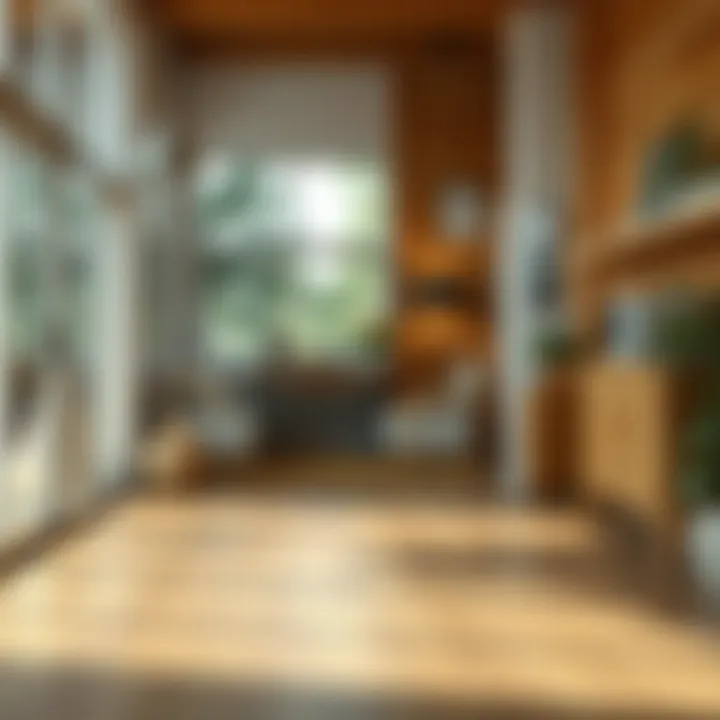
Instead, opt for pH-neutral detergents specifically formulated for laminate surfaces. Not only do they clean effectively, but they won’t compromise the finish. When searching for the right cleaning solution, always check labels or seek recommendations from the manufacturer's website.
"A fool and his money are soon parted," but a wise homeowner knows how to safeguard their investment.
Excessive Moisture Usage
Another mistake that can be the difference between a pristine floor and a warped one is using too much water. Laminate flooring isn't a fan of standing water, and excess moisture can seep between the boards, causing swelling or, worse, mold. Imagine your beautifully designed interior slowly becoming unkempt because of a simple oversight.
To avoid this, make sure your cleaning cloth or mop is damp, not soaked. When wet cleaning, a microfiber mop is particularly nimble, allowing you to manage moisture levels effectively. After each cleaning session, it's also a good idea to check the area for excess dampness and dry it off with a towel if necessary.
In summary, by steering clear of incorrect cleaning agents and excessive moisture usage, you enhance not only the life of your flooring but also the overall integrity of your home environment. A little awareness goes a long way in keeping laminate wood floors in tip-top shape.
Maintaining Laminate Floors Between Deep Cleans
Keeping laminate floors in tip-top shape, especially in between those thorough cleanings, is a game changer for maintaining their aesthetic appeal and durability. Neglecting this routine can lead to stubborn stains, scratches, and a generally drab appearance, which are often more challenging to tackle than a regular maintenance schedule would suggest. Think of it like keeping a shiny car; if you let grime build up, the cleaning isn’t just tougher—it can alter the finish as well.
Regular upkeep requires minimal effort and can yield significant results. Care for your laminate floor not only enhances its visual appeal, but it also prolongs its life. Here’s how to ensure your investment stays looking good as new!
Regular Maintenance Routines
Establishing a routine is the cornerstone of maintaining laminate floors. You don’t need to dedicate entire afternoons to keep things looking sharp. A few small, consistent practices can do wonders.
- Daily Sweeping or Vacuuming: Sweeping with a microfiber broom or vacuuming with a soft-bristle attachment can keep dirt and dust at bay. This routine stops debris from scratching the surface and makes sure the area stays clean.
- Weekly Damp Mopping: Incorporate a damp mop as part of your weekly routine. Just remember to wring out the mop so it’s not soaked. Excess water is the enemy—you want to avoid warping!
- Monthly Product Application: Every month, consider using a laminate-safe cleaner that can refresh the surface without leaving residues. It’s kind of like a facial for your floor, bringing back a little luster.
- Protective Measures: Utilize area rugs in high-traffic zones. Place felt pads under furniture legs to minimize scratches and chips. Think of these small investments as insurance for the overall look and feel of your space.
Spot Cleaning Techniques
We all know that accidents happen. Whether it’s a spilled drink or muddy paws dashing through the house, knowing how to tackle stains swiftly will save the day. Good spot cleaning prevents the need for extensive deep cleaning later on.
- Immediate Attention: For spills, the sooner you address them, the better. Blot spills with a clean, dry cloth—don’t rub! Rubbing can push the liquid into the seams, making it harder to clean later.
- Gentle Cleaning Solutions: Mix a few drops of dish soap into warm water or use a dedicated laminate floor cleaner. Apply the solution with a soft cloth, ensuring it stays damp rather than wet.
- Baking Soda for Stubborn Stains: For stickier situations, consider a paste made from baking soda and water. Gently rub on the stain. This natural method is great for handling grease or food-related marks without harsh chemicals.
- Dry Thoroughly: After cleaning, make sure to wipe down the area with a dry cloth. This ensures that no moisture lingers, which could lead to mold or further damage.
Time spent on regular maintenance saves you from bigger headaches in the long run. Prevention is always simpler than correction.
By integrating these routines and techniques, laminate flooring can retain its charm and shine while significantly reducing the need for drastic cleaning interventions. In the end, a little effort here and there keeps things looking pristine!
Addressing Stains and Spills
Keeping laminate floors pristine is no small feat, particularly when it comes to addressing stains and spills. These uninvited guests can mar the floor’s appearance and, if left unchecked, may even lead to long-term damage. Stains, ranging from food spills to pet accidents, not only detract from your floor’s beauty but can create an unhealthy environment. Therefore, recognizing and treating these blemishes promptly is essential for the longevity of your laminate floors.
A well-executed stain and spill management strategy serves multiple purposes. Primarily, it aids in maintaining a clean and attractive living space. From guests admiring your stylish interior to family gatherings, first impressions count. Moreover, effective stain removal can prevent the need for costly repairs or replacements, saving you both money and hassle in the long run.
Identifying Common Stains
When it comes to stains, differentiating between the types is crucial. Some of the most frequent offenders include:
- Food Stains: Grease, sauces, and even sugary drinks can leave stubborn marks.
- Beverage Stains: Coffee, wine, and soda are notorious for their potency against flooring.
- Pet Accidents: Animal waste can result in unsightly spots and odors.
- Ink Marks: From pens and markers, ink stains may seem daunting to deal with.
- Mud and Dirt: Often tracked in from outside, dirt adds to the cleaning challenge.
Identifying the type of stain can help in choosing the most effective removal method. For instance, a coffee stain may require a different approach compared to mud. Knowledge of common stains not only aids in their prompt removal but also helps in using the right cleaning agents and methods.
Specific Treatment Methods
Eliminating stains on laminate flooring often requires a bit of finesse, but there are specific methods for tackling each type effectively. Below is a guide to treating common stains:
- Food Stains: Start by dabbing the area with cool water and a soft cloth. If the stain persists, mix a few drops of dish soap with water and reapply with a clean cloth, then rinse with dry cloth.
- Beverage Stains: For coffee or wine, gently blot the spill immediately without rubbing. Once the majority is absorbed, use a mix of vinegar and water to clean the residue.
- Pet Accidents: Clean the area with a combination of white vinegar and water (1:1 ratio). Follow up with a damp cloth to remove any remaining cleaning solution.
- Ink Marks: Lightly dab the stain with rubbing alcohol on a cloth. Be careful not to saturate the area, and rinse afterward with cool water.
- Mud and Dirt: Let the mud dry completely. Then, simply vacuum or dry mop the area. If stained, use a damp cloth with a gentle cleaner and dry immediately.
Important: Always test any cleaning solution in an inconspicuous area before applying it to the stain. This step ensures that the laminate is not adversely affected by the cleaner.
The Role of Humidity in Flooring Care
Understanding the role humidity plays in maintaining laminate wood floors is essential for any homeowner or cleaning professional. While laminate flooring is designed to withstand many environmental factors, it is not impervious to the effects of moisture in the air. High or low humidity levels can significantly impact the appearance and longevity of your floors, making it crucial to grasp how humidity interacts with your laminate surfaces.
Laminate floors are composed of synthetic materials that can expand and contract with varying humidity levels. Improper humidity conditions can lead to warping, gaps, or even delamination of the flooring layers. Therefore, knowing how to manage these levels can promote a long-lasting and attractive floor finish.
Impact of Humidity Levels
High humidity can create a host of problems for laminate floors. When the air is saturated with moisture, it can seep into the spaces between tiles or planks. This could result in:
- Expansion: Laminate materials can swell when exposed to excess moisture, causing boards to buckle or lift.
- Mold Growth: Increased humidity can promote mold and mildew, leading to unpleasant odors and potential health risks.
- Damaged Adhesives: Laminate flooring often has layers adhered with a variety of adhesives. Excess moisture can weaken these bonds, risking the integrity of the floor.
On the flip side, low humidity is not without its issues. A dry environment can lead to:
- Contraction: Extremely low humidity can cause laminate boards to shrink, which may create unsightly gaps in between tiles.
- Static Electricity: Dry air frequently results in increased static, which can be annoying and may affect your electronics or sensitive equipment.
In short, it's crucial to maintain a balanced humidity level, ideally between 30% and 50%, to keep your laminate flooring in tip-top shape.
Seasonal Care Adjustments
As seasons change, so do the humidity levels in your home. Thus, it's important to adapt your flooring care accordingly.
- Winter Considerations: During colder months, air can become quite dry due to heating systems. Using a humidifier can help raise humidity levels. On the other hand, ensure proper ventilation to prevent stagnant air where mold might thrive.
- Summer Strategies: Humidity tends to rise in summer months. Using dehumidifiers can help mitigate excess moisture. Regularly check for signs of mold or swelling in such months as the risk increases when humidity is high.
- Year-Round Vigilance: Consider using hygrometers to regularly monitor humidity levels across different areas in your home. This can provide data-driven insights for making adjustments to your cleaning and maintenance routines.
"Monitoring humidity isn't just about comfort; it's about preserving the beauty and longevity of your floors."
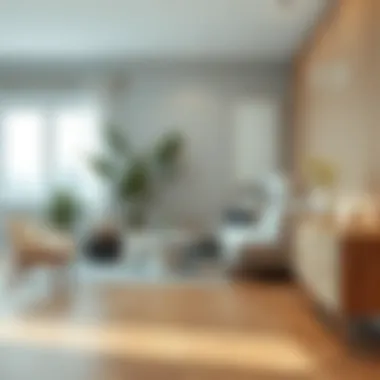
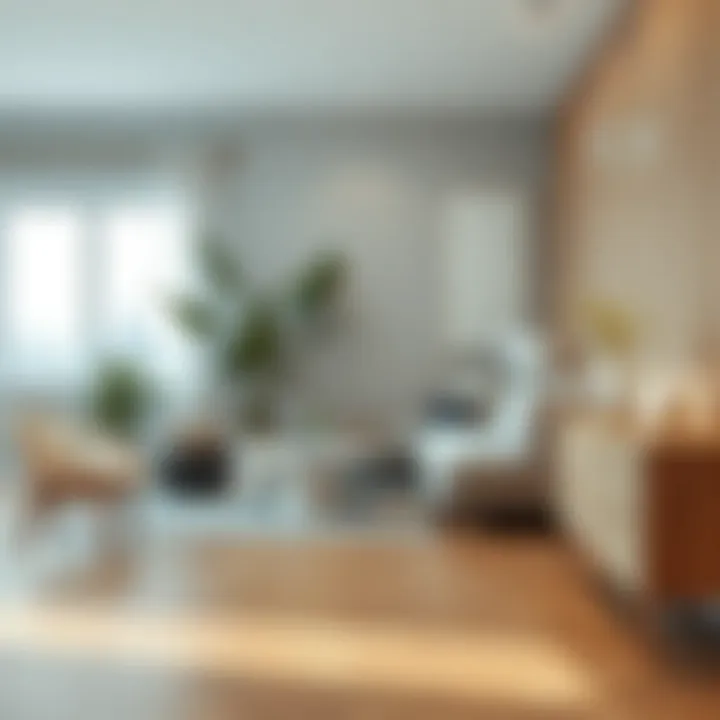
In each season, adjusting your cleaning products may also be necessary. For instance, a damp mop might breathe life back into your floors during dry winters, while during the humid months, you might consider a quick dry method to swiftly remove moisture.
By understanding and managing humidity levels with seasonal adjustments, you can greatly enhance the lifespan and appearance of your laminate wood floors.
Evaluating the Efficacy of Cleaning Products
Choosing the right cleaning products is crucial when it comes to the upkeep of laminate wood floors. The wrong choice can lead to a host of problems—from damage to the finish to ineffective disinfection, ultimately affecting the floor’s longevity and appearance. Misused products can make it look worse before it's even had a real chance to shine. In essence, you’re not just picking something off the shelf; you are investing in the maintenance of your space.
Understanding how to evaluate these products not only helps you make informed decisions but ensures that your efforts are truly beneficial. In today’s market, which is awash with an overwhelming variety of cleaning solutions claiming to be superior, having a strategy for assessment becomes paramount. It’s about sifting through claims and marketing jargon to find what really works.
Understanding Labels and Claims
When you pick up a cleaning product, the label often reads like an enticing menu—"Quick Shine!", "Ultra Clean!", and "Streak-Free Finish!" At first glance, these claims may sound all-too-appealing, but it’s essential to approach them with a critical eye.
- Ingredients List: The first port of call should be the ingredients list. Look for biodegradable components that pose less risk to both your flooring and the surrounding environment. Avoid harsh chemicals, such as ammonium compounds and bleach, as they can degrade the laminate surface over time.
- Safety Certifications: Seek out products that have been certified by recognized organizations that test for safety and efficacy. Sometimes, these products will have benefits listed that appear to validate their effectiveness.
- Directions for Use: Legitimate products should clearly outline how to use them effectively. If a product claims to be a one-size-fits-all solution, take caution. The best results often come from those that offer specific guidelines tailored to different types of cleaning needs.
In assessing these labels, you create a better chance of making a sound decision that doesn’t adversely impact your floors.
Assessing Ingredients
The ingredient list is the backbone of any cleaning product; it holds the secrets to effectiveness and safety. Remember, it’s about what’s inside that counts more than what’s on the label.
- Enzymatic Cleaners: These are often reliable options as they break down organic matter like food residues and stains.
- pH Levels: A product that’s too acidic or too alkaline could be an enemy to your laminate flooring. Neutral pH cleaners are best, as they care for the floor without causing harm.
- Fragrance Additives: While a fresh smell is nice, synthetic fragrances can sometimes hide potential allergens or irritants. If you are sensitive, consider fragrance-free options.
Also, keep an eye on trending natural ingredients. Products derived from plant-based sources can be gentler and often just as effective—think vinegar or baking soda-based cleaners.
Tip: Testing a small, inconspicuous area of your floor with a new product can help prevent unexpected reactions, avoiding a costly mistake.
Taking the time to evaluate both labels and ingredients gives you an edge in the ongoing battle against dirt and disinfectants while preserving the beauty and function of your laminate wood floors.
Long-Term Care for Laminate Flooring
Long-term care for laminate flooring is a critical aspect that deserves not just a passing glance but a thorough examination. It's not only about keeping your floors looking good for the short term; it's about preserving their life, functionality, and overall sheen for years to come. A well-maintained laminate floor can add to the beauty of any home, while neglect can lead to costly replacements and repairs.
Taking the steps to implement proper long-term care makes a world of difference. Not only does it maintain the appearance of the flooring, it also protects the investment made in the home. Caring for laminate means having the right mix of cleaning, preventive measures, and consistent attention.
Protective Measures
Taking protective measures can extend the life of laminate wood floors significantly. Here are some key actions one can take:
- Rug usage: Placing mats at entry points can help trap dirt and moisture before they hit the floor. This simple yet effective step minimizes wear and tear.
- Caution with furniture: Use furniture pads to avoid scratches and dents. Just one shift of a chair can leave a mark, which could become an eyesore over time.
- Avoiding water: Excessive moisture is the enemy. Though laminate flooring is designed to withstand spills, standing water can lead to bubbling and warping.
By understanding how daily actions can impact the laminate’s longevity, homeowners can effortlessly implement small changes into their cleaning routine and household habits.
Professional Maintenance Options
While regular cleaning is essential, sometimes it pays to call in the pros. Professional maintenance options offer specialized knowledge and equipment that may not be accessible at home. Here are a few options to consider:
- Deep cleaning services: These professionals have tools that can remove ingrained dirt and grime that household cleaning can't reach. It’s an effective solution if you notice your floors are looking duller than they used to.
- Refinishing available: Some companies can help refresh the surface of old laminate floors, offering a new lease on life. This option can make them look brand new at a fraction of the cost of replacing them entirely.
- Consultation for moisture control: Experts can assess the home's environment, focusing on humidity levels and suggesting adjustments that can prevent future damage.
Keeping laminate flooring in peak condition is a worthwhile endeavor. The right care enhances beauty and durability, ensuring it's the crown jewel of your home.
Sustainability Considerations in Floor Care
Understanding sustainability in floor care is more than just a trend; it's a movement towards responsible living. People today are more conscious of their choices, especially regarding products that affect the environment. While laminate wood floors are attractive for their aesthetics and practicality, the chemicals and materials used in their maintenance can pose risks to environmental sustainability. This section explores the importance of sustainable practices related to cleaning and maintaining these floors.
Eco-Friendly Cleaning Products
When it comes to selecting cleaning agents, eco-friendly options are paramount. Traditional cleaning products can contain harsh chemicals that not only damage laminate surfaces but also harm the environment. Many of these products end up in waterways, contributing to pollution and adversely affecting aquatic life. By choosing biodegradable or plant-based cleaning solutions, you help mitigate this impact. For instance, you might consider products from companies that prioritize sustainability, like Method or Seventh Generation, which offer effective cleaning without compromising the planet.
Here are some advantages of opting for eco-friendly products:
- Reduced chemical exposure: This is crucial for households with children or pets.
- Lower environmental impact: Fewer pollutants are released into ecosystems.
- Better indoor air quality: Green cleaners can help avoid harmful fumes often associated with typical cleaning agents.
Furthermore, some natural cleaning agents include vinegar and baking soda, which not only provide a deep clean but are inexpensive and safe. It's like finding a two-for-one deal in the cleaning aisle, ensuring your floors sparkle without the guilt of using harmful substances.
Reducing Waste in Cleaning Processes
Sustainability isn’t just about what products we use; it’s also about how we use them. Reducing waste during the cleaning process can significantly contribute to environmental conservation. This involves not only minimizing the number of products you use but also being smart about the tools involved. Consider the following practices:
- Microfiber mops: These are reusable and can be washed many times, cutting down on the use of disposable mops and pads.
- Concentrated cleaning solutions: Buying concentrated products can lower the number of bottles produced and thrown away.
- Bulk purchasing: When possible, buy in bulk to reduce packaging waste.
- DIY solutions: Making your own cleaning solutions reduces dependence on store-bought products, which often come in plastic packaging.
Reducing waste fits into a wider context of environmental responsibility that many homeowners—and indeed, renters—are striving for. These small adjustments in cleaning habits can lead to lasting changes, encouraging a mindset focused on sustainability.
"Every time we choose to clean green, we're not just nurturing our living spaces; we're nurturing our planet."
The End
In wrapping up our comprehensive guide on cleaning and disinfecting laminate wood floors, it becomes clear that this task is about more than just aesthetics. Maintaining the look and feel of your laminate doesn't just enhance your home's appearance; it contributes significantly to its overall value and longevity.
First and foremost, establishing a regular cleaning routine is vital. Laminate floors can act like a magnet for dust and dirt. Regular sweeping or vacuuming keeps abrasive particles from scratching the surface. But cleaning goes beyond just sweeping; using the right products ensures that no harmful residues linger post-clean. In our previous sections, we covered how effective cleaning solutions and proper tools are instrumental in both the short-term cleanliness and long-term preservation of your flooring.
Disinfection moves the goalposts further, safeguarding your space from germs and pathogens. In households with children or pets, the importance of this cannot be overstated. Disinfecting goes hand-in-hand with cleaning. It's all about creating a safe environment while still being conscious about the health of your flooring. Choosing the right disinfectants and applying them correctly helps strike that delicate balance between hygiene and maintaining the integrity of the laminate.
Another aspect to consider is the impact cleaning and disinfecting have on maintaining your laminate’s sheen. Over time, improper cleaning methods can lead to dull finishes and even peeling laminate edges. This highlights the importance of selecting appropriate cleaning methods—something that this article aimed to clarify through detailed instructions and common pitfalls to avoid.
It's equally important to recognize that care is continuous. Keeping up with basic maintenance can help prevent major issues down the line. Regular inspections and timely spot-cleaning of spills can save you a headache. A proactive approach truly pays off in the long run.





